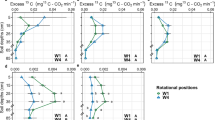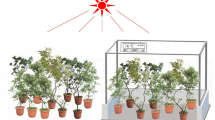Abstract
The seasonal fluctuation of N, P, K, Ca and Mg in leaves, young stems and fruits of young and matureQuercus suber trees growing at the same site was studied. Nutrient dynamics within the tree appeared to be linked to phenological events. Leaves maximized their nutrient contents throughout summer whereas stems maintained rather constant values during most of the year. Before the spring growth flush they apparently acted as temporary reservoirs for some nutrients, translocated from leaves or other organs, so that such nutrients would be easily invested in the new tissues. A significant investment was made in sink organs like flowers and fruits. The tree probably relies not only on leaves but also on other nutrient reservoirs like older branches and roots for an adequate supply to those sinks and to the spring growth. The importance of the sampling dates and the basis of expression used for nutrient concentrations has also been emphasized. Nutrient contents and seasonal trends of the studied trees were similar to those of other evergreen oaks, although somewhat higher values for N, K, and Mg were found. Moreover, soil nutrient contents in the studied “montado” were much lower than in other Iberic oak stands. However the nutrient status and requirements of cork-oak suggest high (or at least adequate) nutrient availability to the trees. The mechanisms by which this could be achieved are discussed.
Similar content being viewed by others
References
Aerts R (1989) Nitrogen use efficiency in relation to nitrogen availability and plant community composition. In: Lambers H et al (eds) Causes and consequences of variation in growth rate and productivity of higher plants. SPB Academic Publishing, The Hague, pp 285–297
Amaranthus MP, Perry DA (1994) The functioning of ectomycorrhizal fungi in the field: linkages in space and time. Plant Soil 159: 133–140
Amaro FS (1988) Azinheira: a fronteira que nos separa do deserto. Bol Inst Prod Florest Cortiça 594: 94–98
Benton Jones J Jr, Wolf B, Mills HA (eds) (1991) Plant analysis handbook. Micro-Macro, Athens, USA
Berg B, McClaugherty C (1989) Nitrogen and phosphorus release from decomposing litter in relation to the disappearance of lignin. Can J Bot 67: 1148–1156
Bloom AJ, Chapin III FS, Mooney HA (1985) Resource limitation in plants — an economic analogy. Annu Rev Ecol Syst 16: 363–392
Bonilla D, Rodà F (1992) Soil nitrogen dynamics in a holm oak forest. Vegetatio 99-100: 247–257
Canadell J, Vilá M (1992) Variation in tissue element concentrations inQuercus ilex L. over a range of different soils. Vegetatio 99-100: 273–282
Chapin FS, Schulze E-D, Mooney HA (1990) The ecology and dynamics of storage in plants. Annu Rev Ecol Syst 21: 423–447
Curl EA, Truelove B (1986) The rhizosphere. Advanced series in agricultural sciences. Springer, Berlin Heidelberg New York
Escarré A, Ferrés L, Lopez R, Martin J, Rodà F, Terrades J (1987) Nutrient use strategy by evergreen-oak (Quercus ilex L.) in NE Spain. In: Tenhunen JD, Catarino FM, Lange OL, Oechel WC (eds) Plant response to stress. Functional analysis in Mediterranean ecosystems, NATO ASI Series, vol G15. Springer, Berlin Heidelberg New York, pp 429–435
Escudero A, Garcia B, Gomez JM, Luis E (1985) The nutrient cycling inQuercus rotundifolia andQuercus pyrenaica ecosystems (“dehesas”) of Spain. Acta Oecol 6 (20), n. 1: 73–86
Escudero A, del Arco JM, Garrido MV (1992 a) The efficiency of nitrogen retranslocation from leaf biomass inQuercus ilex ecosystems. Vegetatio 99–100: 225–237
Escudero A, del Arco JM, Sanz IC, Ayala J (1992b) Effects of leaf longevity and retranslocation efficiency on the retention time of nutrients in the leaf biomass of different woody species. Oecologia 90: 80–87
Field C, Mooney HA (1986) The photosynthesis-nitrogen relationship in wild plants. In: Givnish TJ (ed) On the economy of plant form and function. Cambridge University Press, Cambridge, pp 25–55
Field C, Merino J, Mooney HA (1983) Compromises between wateruse efficiency and nitrogen-use efficiency in five species of Californian evergreens. Oecologia 60: 384–389
Fouseki E, Margaris NS (1981) Soil metabolism and decomposition in a phryganic (East Mediterranean) ecosystem. Oecologia 50: 417–421
Garten CT Jr (1976) Correlations between concentrations of elements in plants. Nature 261: 686–688
Harrington RA, Brown BJ, Reich PB (1989) Ecophysiology of exotic and native shrubs in Southern Wisconsin. I. Relationship of leaf characteristics, resource availability, and phenology to seasonal patterns of carbon gain. Oecologia 80: 356–367
Hollinger DY (1986) Herbivory and the cycling of nitrogen and phosphorous in isolated California oak trees. Oecologia 70: 291–297
Joffre R, Vacher J, de los Llanos C, Long G (1988) The dehesa: an agrosilvopastoral system of the Mediterranean region with special reference to the Sierra Morena area of Spain. Agroforest Syst 6: 71–96
Johnson JE, Burger JA, Rathfon RA, Kreh RE, Feret PP (1991) Foliar nutrient comparisons of pitch pine, loblolly pine, and the pitch x loblolly hybrid. Plant Soil 132: 1–9
Jonasson S (1989) Implications of leaf longevity, leaf nutrient reabsorption and translocation for the resource economy of five evergreen plant species. Oikos 56: 121–131
Kost JA, Boerner REJ (1985) Foliar nutrient dynamics and nutrient use efficiency inCornus florida. Oecologia 66: 602–606
Le Houérou HN (1981) Impact of man and his animals on Mediterranean vegetation. In: di Castri F, Goodall DH, Specht RL (eds) Mediterranean type shrublands. Ecosystems of the World 11. Elsevier, New York, pp 479–521
Loureiro NFS (1990) Alguns indicadores morfo-estruturais e teores de nutrientes foliares emQuercus suber L. eArbutus unedo L., estimados em Portugal Continental e correlacionados com o coeficiente evaporative de Specht. Master of Science Thesis, CIHEAM-Instituto Agronómico Mediterráneo de Zaragoza, Zaragoza
Madeira MAV, Serralheiro FM (1990) Decomposição de folhas de sobreiro e eucalipto e colonização pela mesofauna. Resultados preliminares. Pedon 9: 3–20
Mayor X, Rodà F (1992) Is primary production in holm oak forests nutrient limited? A correlational approach. Vegetatio 99–100: 209–217
Millard P (1993) A review of internal cycling of nitrogen within trees in relation to soil fertility. In: Fragoso MAC, van Beusichem ML (eds) Optimization of plant nutrition. Kluwer, Dordrecht, pp 623–628
Millard P (1994) Measurement of the remobilization of nitrogen for spring leaf growth of trees under field conditions. Tree Physiol 14: 1049–1054
Mooney HA, Kummerow J (1981) Phenological development of plants in mediterranean-climate regions. In: di Castri F, Goodall DW, Specht RL (eds) Mediterranean type shrublands. Ecosystems of the World 11. Elsevier, Amsterdam, pp 303–307
Mooney HA, Rundel PW (1979) Nutrient relations of the evergreen shrub,Adenostoma fasciculatum in the California chaparral. Bot Gaz (Chicago) 140: 109–113
Natividade JV (1950) Subericultura. Ministério da Economia, Direcção Geral dos Servicos Florestais e Aquicolas, Lisbon
Nilsen ET, Schlesinger WH (1981) Phenology, productivity, and nutrient accumulation in the post fire chaparral shrubLotus scoparius. Oecologia 50: 217–224
Oliveira G, Correia O, Martins-Loução MA, Catarino FM (1992) Water relations of cork oak (Quercus suber L.) under natural conditions. Vegetatio 99–100: 199–208
Oliveira G, Correia O, Martins-Loução MA, Catarino FM (1994) Phenological and growth patterns of the Mediterranean oakQuercus suber L. Trees 9: 41–46
Pugnaire FI, Chapin III FS (1993) Controls over nutrient resorption from leaves of evergreen mediterranean species. Ecology 74: 124–129
Rapp M, EdDerfoufi F, Blanchard A (1992) Productivity and nutrient uptake in a holm oak (Quercus ilex L.) stand and during regeneration after clearcut. Vegetatio 99–100: 263–272
Read DJ (1993) Mycorrhiza in plant communities. In: Ingram DS, Williams PH (eds) Advances in plant pathology, vol 9. Academic Press, London, pp 1–31
Reich PB, Walters MB (1994) Photosynthesis-nitrogen relations in Amazonian tree species. II. Variation in nitrogen vis-a-vis specific leaf area influences mass- and area-based expressions. Oecologia 97: 73–81
Reich PB, Walters MB, Ellsworth DS, Uhl C (1994) Photosynthesisnitrogen relations in Amazonian tree species. I. Patterns among species and communities. Oecologia 97: 62–72
Rundel PW (1988) Vegetation, nutrition and climate — examples of integration. Leaf structure and nutrition in mediterranean-climate sclerophylls. In: Specht RL (ed) Mediterranean type ecosystems — a data source book. Tasks for Vegetation Science 19. Kluwer Dordrecht, pp 157–167
Schulze E-D, Chapin III FS (1987) Plant specialization to environments of different resource availability. In: Schulze E-D, Zwölfer H (eds) Ecological studies, vol 61. Springer, Berlin Heidelberg New York, pp 120–148
Silver WL (1994) Is nutrient availability related to plant nutrient use in humid tropical forests? Oecologia 98: 336–343
Specht RL (1988) Vegetation, nutrition and climate-data tables. Natural vegetation — ecomorphological characters. In: Mediterranean type ecosystems — a data source book. Tasks for Vegetation Science 19. Kluwer, Dordrecht, pp 13–80
Stepien V, Sauter JJ, Martin F (1994) Vegetative storage proteins in woody plants. Plant Physiol Biochem 32: 185–192
Author information
Authors and Affiliations
Rights and permissions
About this article
Cite this article
Oliveira, G., Martins-Loução, M.A., Correia, O. et al. Nutrient dynamics in crown tissues of cork-oak (Quercus suber L.). Trees 10, 247–254 (1996). https://doi.org/10.1007/BF02185676
Received:
Accepted:
Issue Date:
DOI: https://doi.org/10.1007/BF02185676




